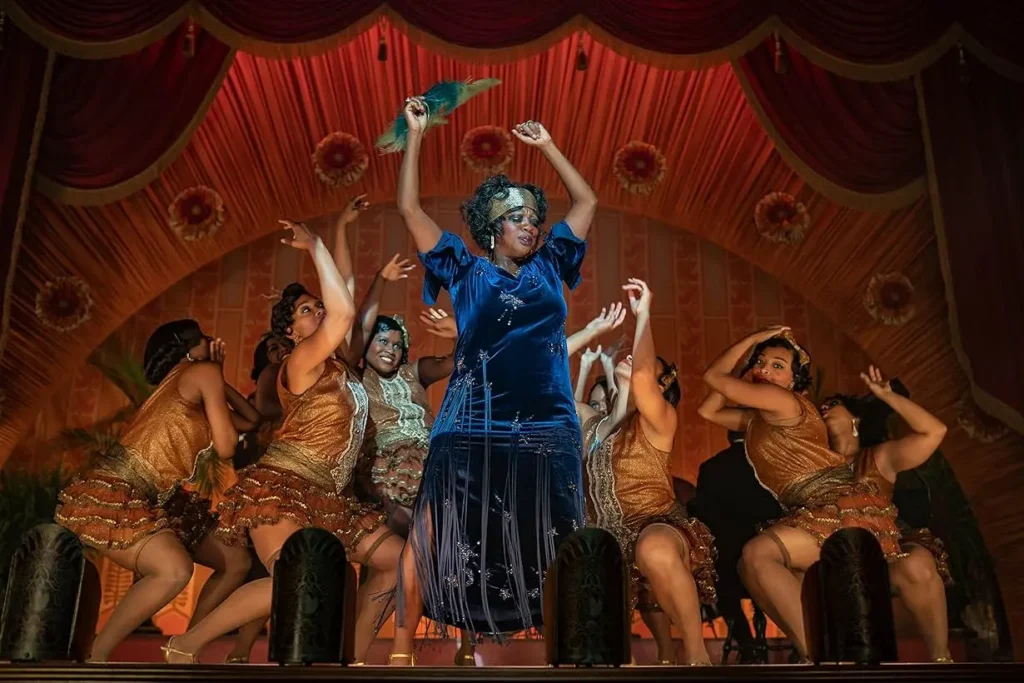
Introduction
“Ma Rainey’s Black Bottom” is a film that captivates its audience not just with its riveting performances but with its incredible costume design. The film, based on August Wilson’s play, transports viewers back to 1920s Chicago, a time when music and fashion were transforming rapidly. Costumes in this movie aren’t just clothing; they’re an essential part of the storytelling. They reflect the characters’ personalities, their aspirations, and their struggles in a racially segregated world. In this review, we’ll break down the significance of the costumes, the mastermind behind their design, and how they elevate the film’s narrative.
Table of Contents
About the Movie
“Ma Rainey’s Black Bottom” is set during a single, tense recording session in Chicago, revolving around the iconic blues singer Ma Rainey and her band. Viola Davis shines as the defiant and powerful Ma Rainey, while Chadwick Boseman plays the ambitious, yet troubled trumpet player, Levee. The film’s narrative unfolds largely in the recording studio, where racial tensions, power struggles, and personal aspirations collide. The confined setting puts even more pressure on the costumes to communicate the period, the characters’ identities, and the social backdrop of 1920s America. The costumes don’t just fit the era—they become a visual extension of the film’s emotional and thematic depth.
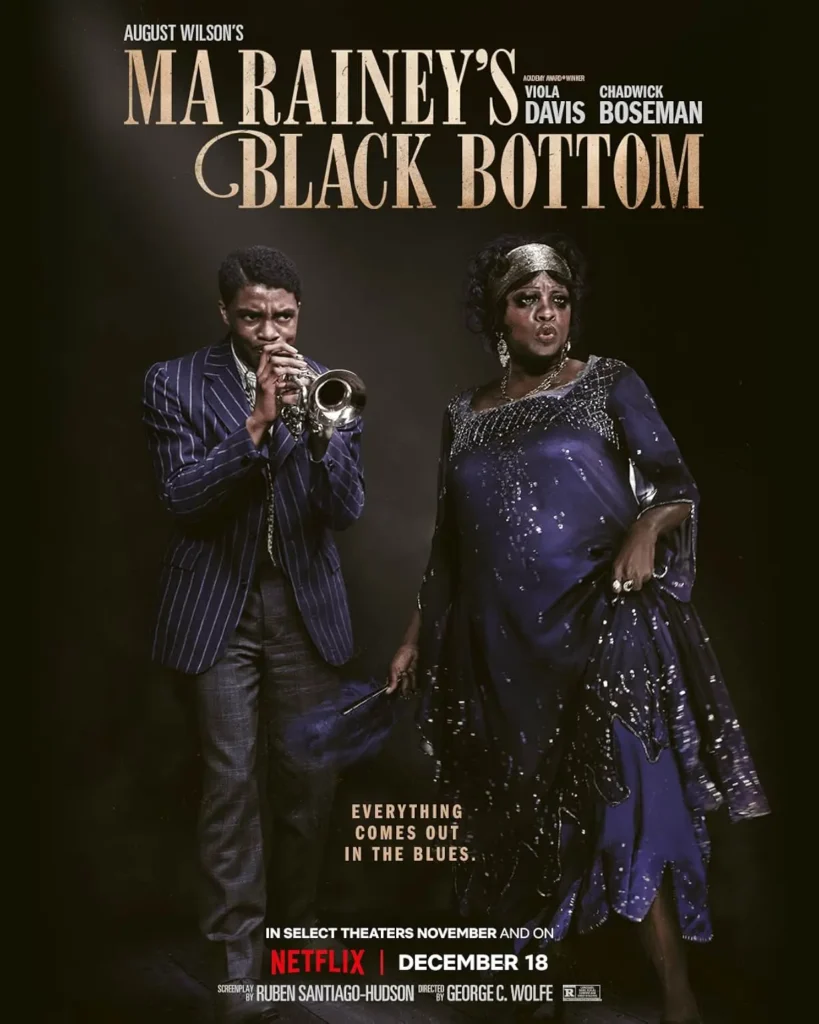
photo/imdb
Watch the Trailer
Significance of Costumes in “Ma Rainey’s Black Bottom”
Costumes in “Ma Rainey’s Black Bottom” serve as more than just historical markers. They act as windows into the souls of the characters, visually narrating their inner struggles, their desires, and their societal positions. For Ma Rainey, her bold and extravagant outfits showcase her defiance and control in a white-dominated industry. On the other hand, Levee’s more modern, flashy attire speaks to his ambition, his desire to rise above his current circumstances, and his internal conflicts. These costumes play a pivotal role in shaping how the audience views and connects with each character. They are as crucial to the film’s storytelling as the dialogue and performances themselves.
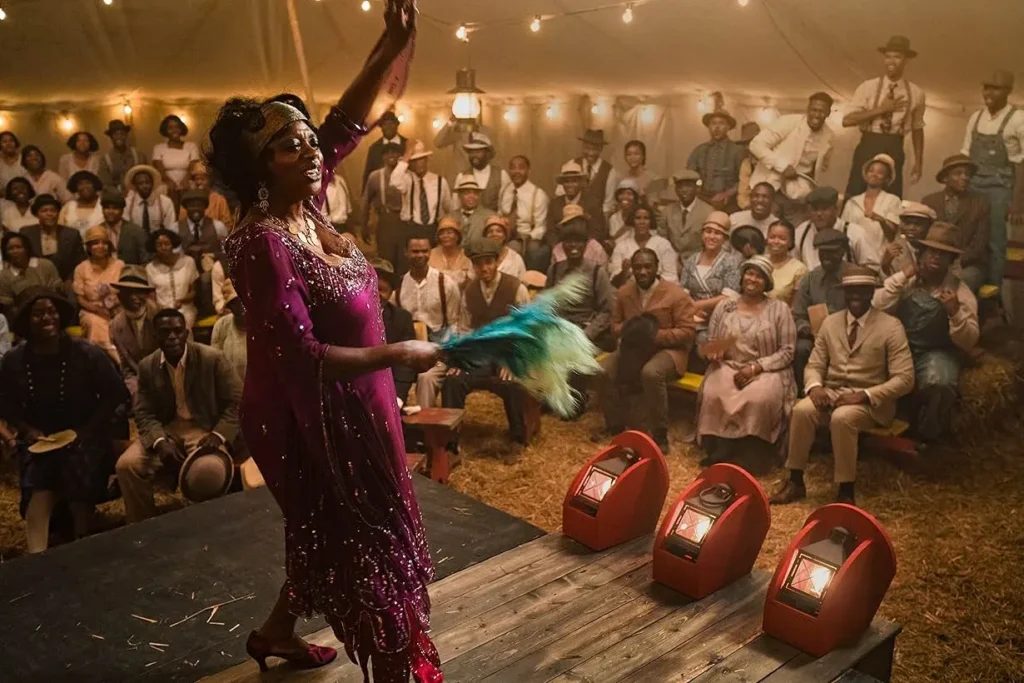
photo/imdb
About the Designer: Ann Roth
Background and Career
Ann Roth is nothing short of a legend in the world of costume design. With a career that spans over five decades, she’s responsible for creating the iconic looks in numerous films and stage productions. Roth’s strength lies in her ability to blend historical accuracy with deep character analysis. Her designs are never just about replicating a time period; they’re about bringing characters to life in a way that feels authentic and deeply personal. She has a unique talent for diving into the psychology of the characters she dresses, ensuring that each piece of clothing tells part of their story.

photo/observer
Other Notable Works
Ann Roth’s filmography is extensive and illustrious. Some of her most famous works include “The English Patient,” for which she won her first Academy Award, and “The Birdcage,” where she showcased her versatility in handling comedic, vibrant costumes. She also designed the costumes for “The Post,” a film set in the 1970s, and “Angels in America,” a miniseries that spanned multiple decades. Roth’s ability to adapt her designs to fit various time periods, genres, and tones has made her one of the most respected figures in costume design.
Inspiration Behind the Costume Design
Setting and Era of the Film
The film is set in 1927 Chicago, a time when jazz was flourishing, and clothing was a reflection of one’s societal standing, profession, and even personality. The roaring twenties were known for bold colors, lavish fabrics, and intricate accessories, which Roth took full advantage of in designing the characters’ outfits.
Research and Preparation
Roth’s dedication to research is evident in every stitch. She delved into the fashion archives of the 1920s, studying fabrics, patterns, and accessories that reflected both wealth and struggle. Her designs were rooted in the socio-economic realities of the time, ensuring that each costume would narrate its own story.
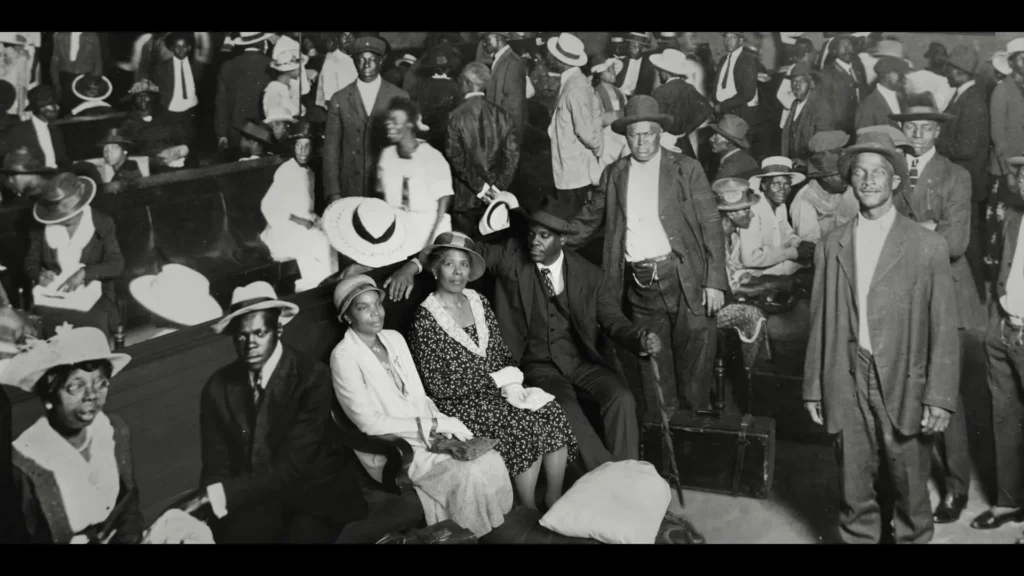
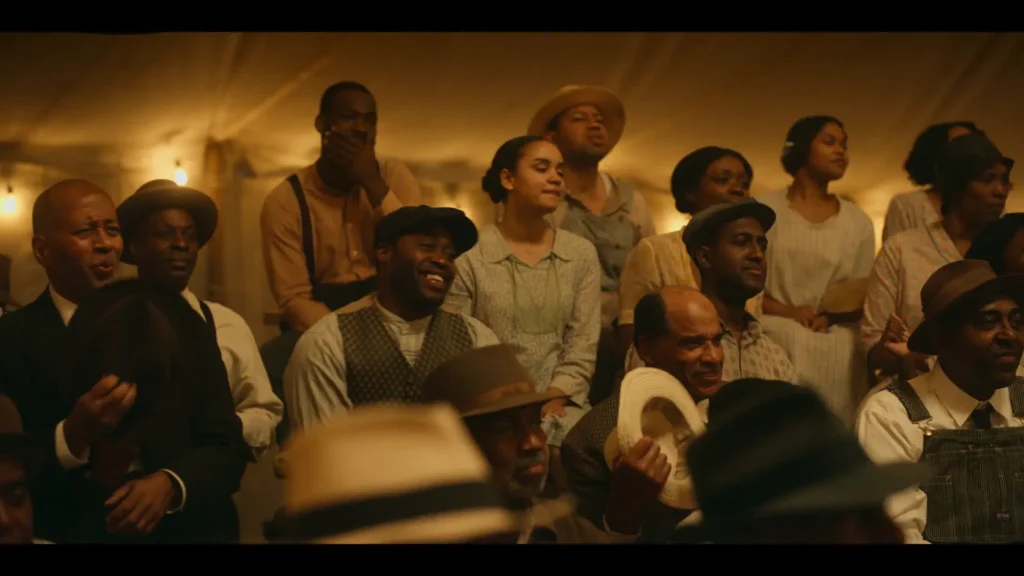
photo/snapshot from the movie
Historical Accuracy in Costume Design
1920s Fashion Overview
The 1920s were a time of cultural and social transformation, and fashion was no exception. Women’s fashion broke away from the restrictive corsets of previous decades, opting for looser silhouettes, shorter hemlines, and more daring styles. The flapper look, with its beaded dresses, cloche hats, and bobbed hair, became iconic. For men, suits became more relaxed, and jazz culture introduced bolder, more expressive clothing choices, with a focus on sharp tailoring, wide-legged trousers, and snazzy accessories like hats and spats. “Ma Rainey’s Black Bottom” captures this period perfectly, transporting viewers to a world where fashion was a reflection of societal shifts.
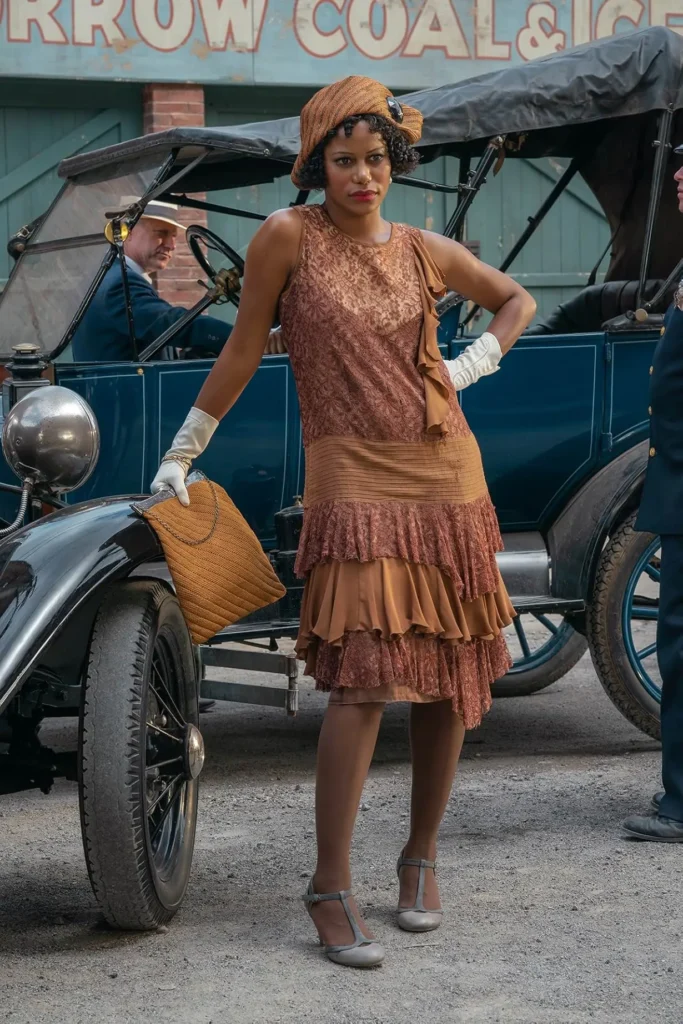
photo/imdb
Capturing Ma Rainey’s Iconic Style
Ma Rainey’s costumes had to be larger than life because that’s exactly who she was. Known as the “Mother of the Blues,” Ma Rainey had a stage presence that was as powerful as her voice. Ann Roth did a remarkable job of capturing her flamboyant, unapologetic style. The film features opulent dresses adorned with fur, sequins, and luxurious fabrics, reflecting both her success and her refusal to conform to societal expectations. These outfits were not just historically accurate; they were symbolic of Ma Rainey’s dominance in a male-dominated industry, where her clothes acted as armor against a world that sought to control her.
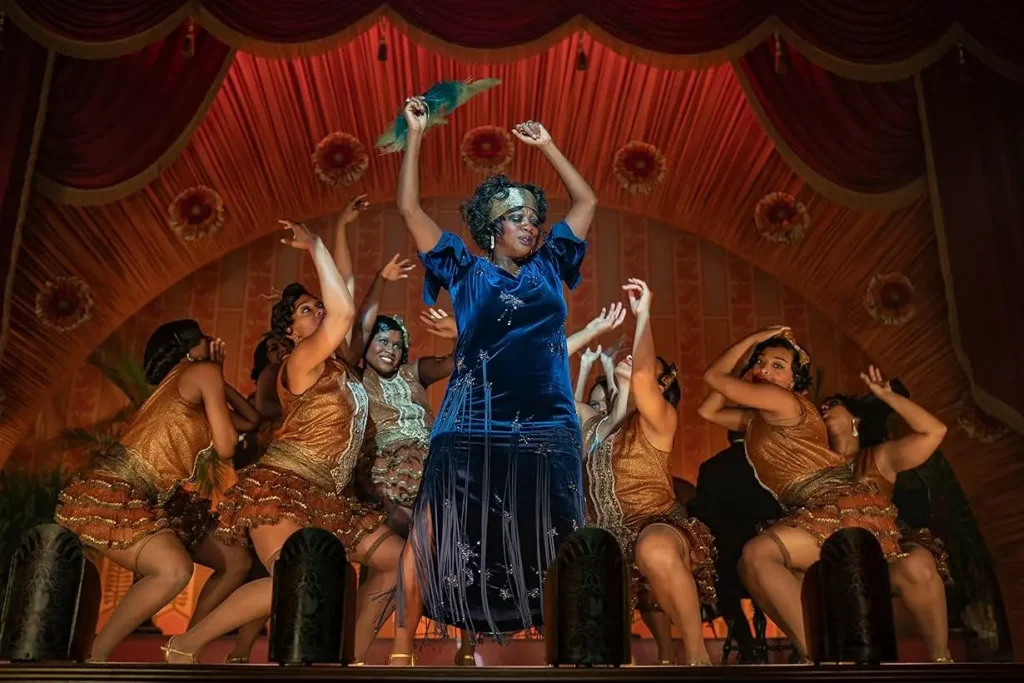
photo/imdb
Levee’s Costume: A Reflection of His Personality
Levee, played brilliantly by Chadwick Boseman, is a character with big dreams but an even bigger chip on his shoulder. His costume reflects this duality. Levee’s flashy, modern suit immediately sets him apart from the other band members, signaling his desire to rise above his current situation. He wants to be noticed, and his clothing is a reflection of that ambition. However, as the story progresses, it becomes clear that Levee’s outward confidence hides deep insecurities and frustrations. His suit, while stylish, doesn’t carry the same weight or authority as Ma Rainey’s outfits, highlighting the gap between his aspirations and his reality.
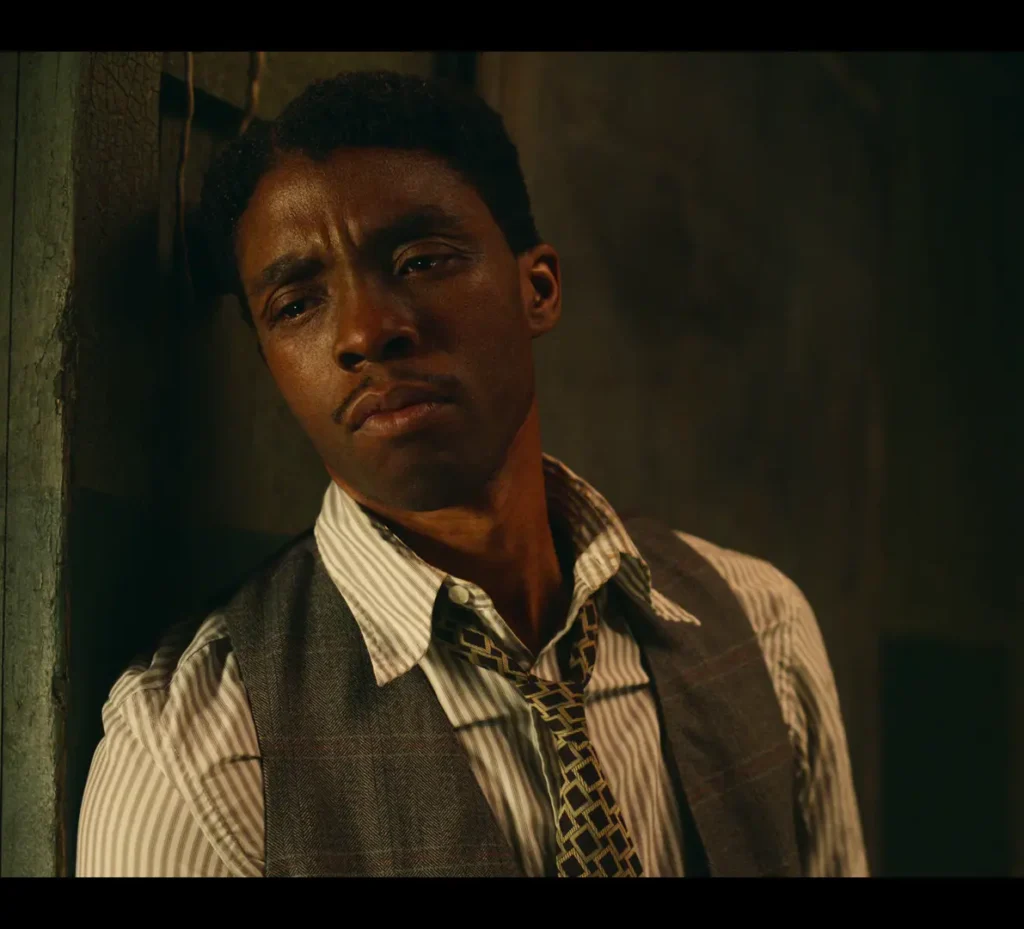
photo/snapshot from the movie
Band Members’ Distinct Styles
The other band members wear more muted, functional clothing that reflects their working-class status. Their costumes are understated but carefully tailored to reflect their different personalities—from the reserved nature of Toledo to the laid-back style.
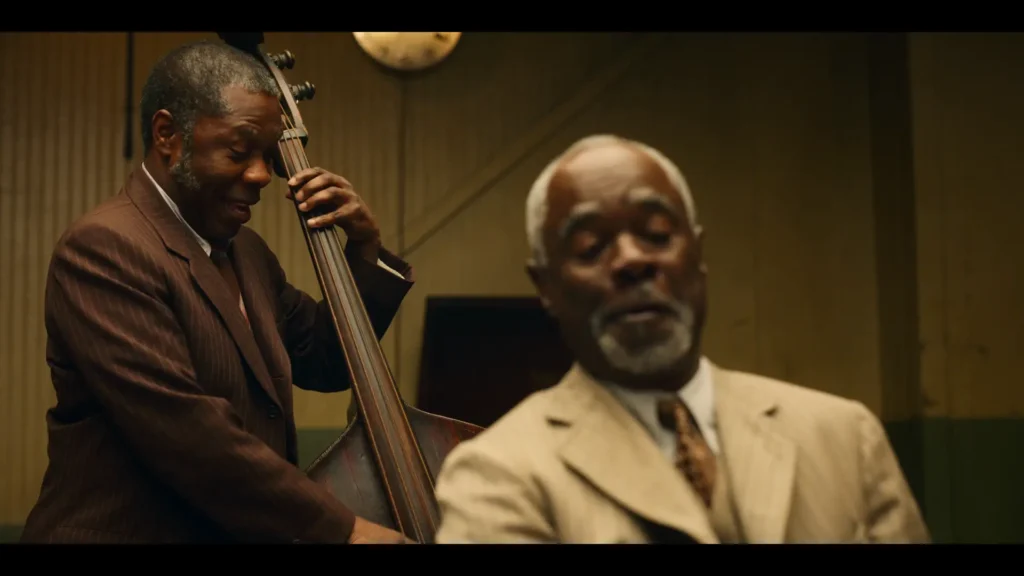
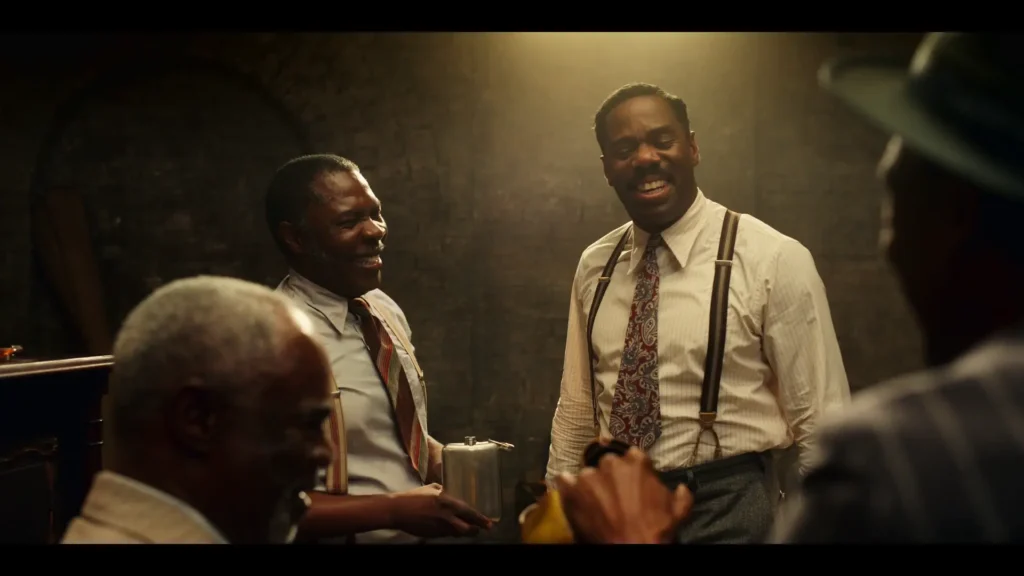
photo/snapshot from the movie
Ma Rainey’s Outfits: Commanding Presence Through Style
Her Stage Performance Attire
On stage, Ma Rainey is a force to be reckoned with, and her performance outfits reflect that power. Ann Roth designed stage costumes that are bold and ostentatious, using rich colors and heavy fabrics to convey Ma’s larger-than-life personality. Sequins, fur, and feathers are used liberally, showcasing the blues singer’s unapologetic flamboyance. These outfits are meant to draw the eye, commanding attention just as Ma Rainey commands the stage. The contrast between her extravagant stage attire and the more subdued costumes of the band members emphasizes her dominance within the group and the industry.
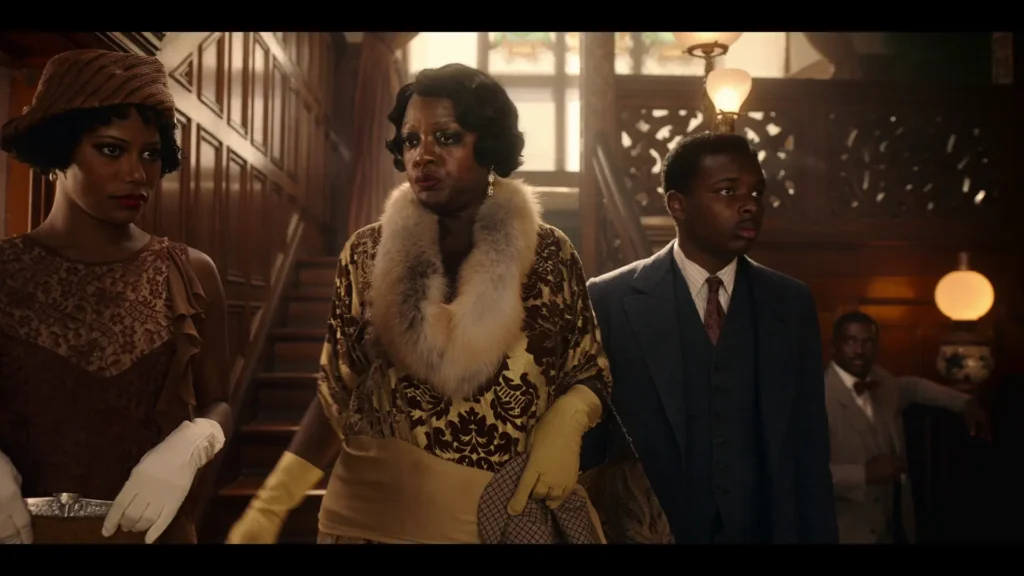
photo/snapshot from the movie
Off-Stage Costumes
Off-stage, Ma Rainey’s costumes remain luxurious but show a different side of her character. They are less about performance and more about self-expression. Her off-stage outfits still exude wealth and power, but they also offer glimpses into her personal life, showing that Ma Rainey is not just a performer but a woman who knows her worth. Whether she’s draped in velvet or adorned with pearls, her clothing consistently communicates her status and confidence, even when she’s not in the spotlight.
Costume Designing Facts
Fabric Choices
The choice of fabrics in “Ma Rainey’s Black Bottom” was crucial in creating the luxurious, authentic look of the 1920s. Velvet, silk, and fur were used to reflect the wealth and status of Ma Rainey, while the lighter fabrics of the band members’ costumes reflected their more modest means. The texture of the fabrics also played a role in creating visual contrast between characters. The richness of Ma’s clothing stood in stark opposition to the simpler, more functional outfits of the other musicians, highlighting the power dynamics at play.
Color Palette
The film’s color palette was carefully chosen to reflect the emotional tone and the personalities of the characters. Ma Rainey’s costumes featured deep, regal colors like purple and gold, emphasizing her authority and grandeur. Levee’s costumes, on the other hand, were brighter and more vibrant, signifying his youthful ambition and desire for success. The use of contrasting colors between Ma and Levee visually reinforced the differences in their personalities and their places in the world. Ma’s dark, rich tones made her appear grounded and powerful, while Levee’s lighter colors gave him an air of fragility and ambition.
Incorporating Authentic Accessories
Accessories played a vital role in grounding the film in its 1920s setting. Ma Rainey’s extravagant jewelry, including heavy necklaces and sparkling earrings, added to her commanding presence, while her fur stoles and hats completed her opulent look. Levee’s shoes were another key detail; their shine and flashiness reflected his desire to be noticed, but they also symbolized his focus on surface appearances rather than substance. Every accessory in the film was chosen with precision to reflect not just the time period but the deeper layers of each character’s personality.
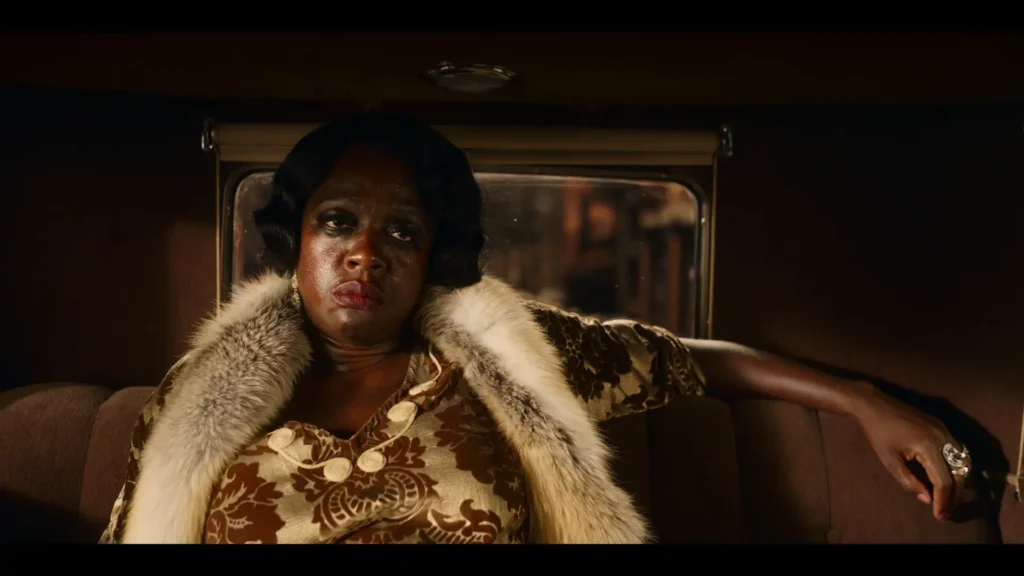
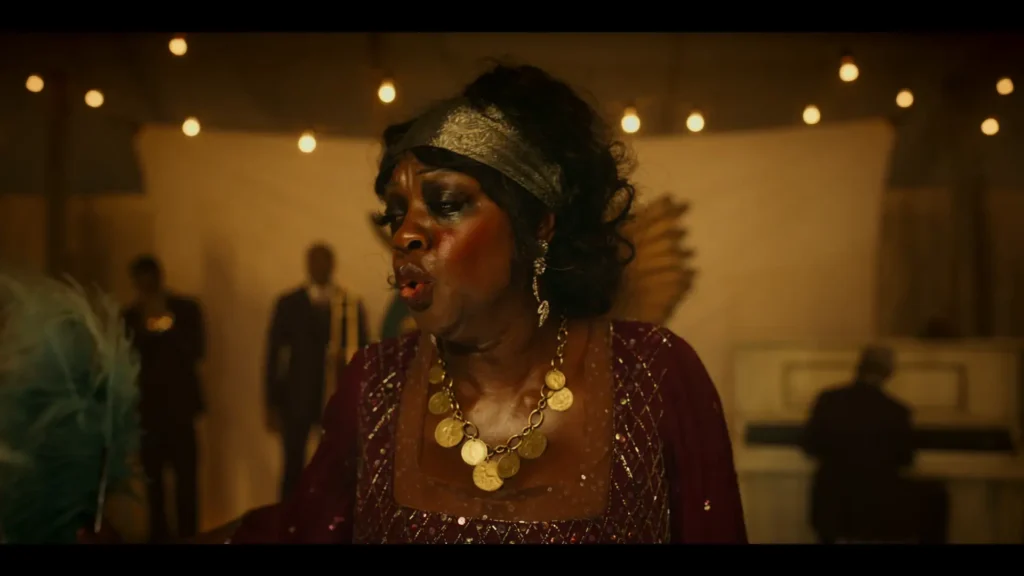
photo/snapshot from the movie
Also Read – Costume Review: Little Women (2019)
Symbolism in Costumes
Ma’s Bold Style vs. Levee’s Aspirational Fashion
The stark contrast between Ma Rainey’s bold style and Levee’s aspirational fashion is one of the most powerful uses of costume symbolism in the film. Ma’s style is established and unwavering. Her outfits are a reflection of her experience, her success, and her knowledge of who she is in the world. Levee’s clothes, on the other hand, represent his dreams and his need to prove himself. His flashy, modern suit is a costume in its own right—a mask that hides his vulnerability and insecurity. The tension between Ma’s confidence and Levee’s aspirations is mirrored in their clothing, providing a visual representation of the generational and ideological clash between them.
Levee’s Sharp Suits: Confidence vs. Vulnerability
Levee’s suits represented his internal conflict. On one hand, they showcased his confidence and desire for a bigger future, but on the other, they revealed his fragility as his dreams gradually slipped out of reach.
Awards and Nominations for Costume Design
Oscar Wins and Recognition
The costumes in “Ma Rainey’s Black Bottom” garnered widespread acclaim, with Ann Roth winning the Academy Award for Best Costume Design. This win was a testament to the detailed and thoughtful approach taken to bring the 1920s to life, and to showcase the depth of the characters through their clothing. The film was also nominated for numerous other awards, including at the BAFTAs and the Costume Designers Guild Awards. Ann Roth’s ability to seamlessly blend historical accuracy with character-driven design was universally praised.
Other Prestigious Nominations
In addition to the Oscars, the costume design for “Ma Rainey’s Black Bottom” earned nominations from several other prestigious organizations, such as the British Academy of Film and Television Arts (BAFTA) and the Critics’ Choice Awards. The recognition of Ann Roth’s work across various platforms highlights the exceptional quality and impact of the costume design in the film. It wasn’t just about dressing actors in period clothing—it was about using those costumes to elevate the story and deepen the audience’s connection to the characters.
Challenges in Designing for the Film
Recreating the Era with Accuracy
One of the most significant challenges was authentically recreating 1920s fashion without overshadowing the film’s plot. Roth had to balance historical accuracy with character-driven design choices.
Balancing Character and Historical Fidelity
While staying true to the era, Roth also ensured that each costume reflected the internal struggles and journeys of the characters, making the costumes more than just period pieces—they became integral to the story.
Impact of Costumes on the Film’s Atmosphere
The costumes enhanced the film’s overall atmosphere by grounding the audience in the time period. They helped create a visual rhythm that matched the movie’s musical roots, making the audience feel immersed in the 1920s jazz scene.
Costumes to Improve
Possible Enhancements for Ma Rainey’s Costumes
While Ann Roth’s work on Ma Rainey’s costumes was nothing short of phenomenal, there could have been more variety in Ma’s off-stage outfits to further differentiate her public and private personas. Perhaps showing a more vulnerable side through softer fabrics or less structured designs could have provided additional layers to her character. By incorporating moments where Ma lets her guard down, the costumes could have added more emotional depth to her personal story.
Refining Levee’s Look
For Levee, a more gradual transition in his costumes throughout the film could have symbolized his growing desperation and loss of control. Starting with his flashy suit and progressively moving to more disheveled or worn attire as his emotional state deteriorates would have visually mirrored his internal journey. This subtle shift in his wardrobe could have enhanced the storytelling, making his tragic arc even more poignant.
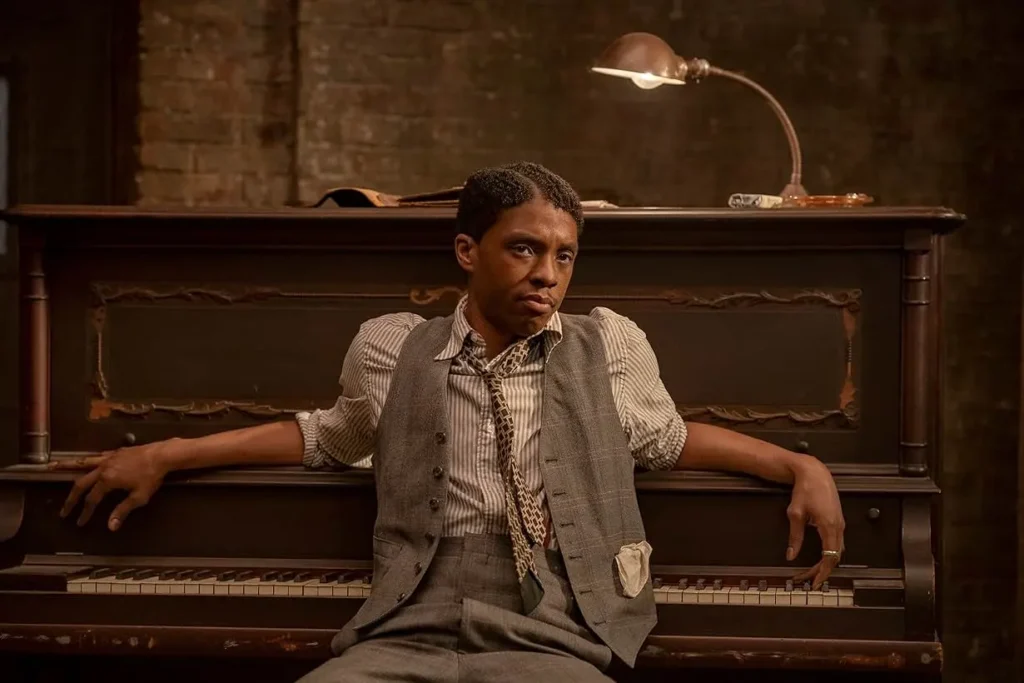
photo/imdb
Ma Rainey’s Black Bottom’s Costume Review at a Glance:
Here’s a detailed table for the costume review of the movie “Ma Rainey’s Black Bottom”:
| Category | Details |
|---|---|
| Movie Title | Ma Rainey’s Black Bottom |
| Main Characters | – Ma Rainey (Viola Davis) |
| – Levee (Chadwick Boseman) | |
| Setting | 1920s Chicago |
| Costume Designer | Ann Roth |
| Historical Accuracy | – Costumes accurately represent 1920s fashion. |
| – Features loose silhouettes, flapper dresses, and sharp suits. | |
| Fabric Choices | – Ma Rainey: Luxurious fabrics like velvet, silk, fur. |
| – Band members: More modest, functional fabrics. | |
| Color Palette | – Ma Rainey: Deep, regal colors (purple, gold) reflecting power. |
| – Levee: Brighter colors representing youthful ambition. | |
| Accessories | – Ma Rainey: Heavy jewelry (pearls, sparkling earrings), fur stoles, hats. |
| – Levee: Shiny shoes, adding to his flamboyant, yet fragile persona. | |
| Costume Symbolism | – Ma Rainey: Bold outfits represent her established confidence and authority. |
| – Levee: Flashy attire symbolizes his ambition and insecurity. | |
| Ma Rainey’s Stage Outfits | – Luxurious, with sequins, fur, and bold colors. |
| – Emphasize her dominance and stage presence. | |
| Ma Rainey’s Off-Stage Costumes | – Less flamboyant but still luxurious, showing her control and personal worth. |
| Levee’s Costume | – Flashy modern suit reflecting his desire to rise above his situation. |
| – Highlights ambition and eventual unraveling. | |
| Awards & Nominations | – Ann Roth won the Academy Award for Best Costume Design. |
| – Nominated for BAFTAs and Critics’ Choice Awards for costume design. | |
| Costume to Improve (Ma Rainey) | – More variety in off-stage outfits to show vulnerability. |
| Costume to Improve (Levee) | – Gradual deterioration in costume to reflect emotional unraveling. |
| Conclusion | Costumes elevate the film’s narrative, portraying character depth, societal tensions, and the 1920s cultural backdrop. |
Conclusion
In “Ma Rainey’s Black Bottom,” costumes play a vital role in transporting the audience to the 1920s and adding depth to the characters. Ann Roth’s brilliant designs not only reflect the period but also enhance the storytelling, making the characters’ internal struggles and societal tensions visible through their clothing. Whether it’s Ma Rainey’s commanding presence in luxurious attire or Levee’s flashy yet fragile persona, the costumes are integral to understanding the characters and the world they inhabit.
FAQs
- Why are the costumes so important in “Ma Rainey’s Black Bottom”?
Costumes help communicate the characters’ personalities, aspirations, and the social context of the 1920s. - Who designed the costumes for “Ma Rainey’s Black Bottom”?
The costumes were designed by the legendary Ann Roth. - Did the film win any awards for its costume design?
Yes, Ann Roth won the Academy Award for Best Costume Design for her work on the film. - How do Ma Rainey’s costumes reflect her character?
Ma’s costumes are bold and extravagant, showcasing her power, confidence, and defiance in a male-dominated industry. - What could have been improved in the costume design?
More variety in Ma Rainey’s off-stage outfits and a gradual evolution in Levee’s costumes could have added additional layers to their characters.
One thought on “Costume review: Ma Rainey’s Black Bottom (2020)”